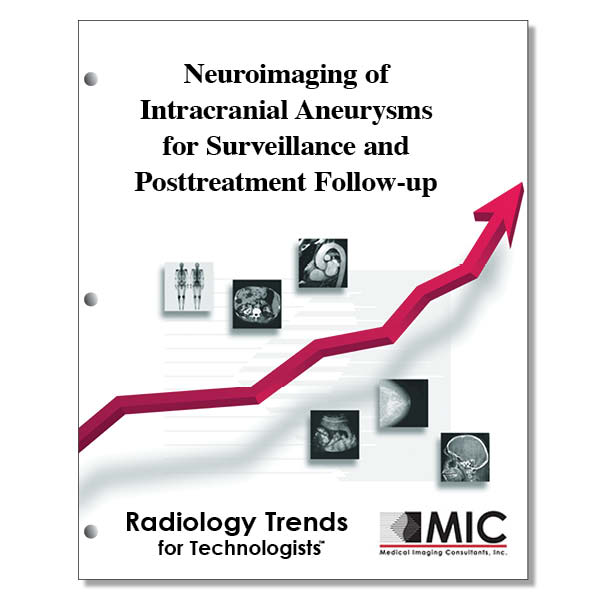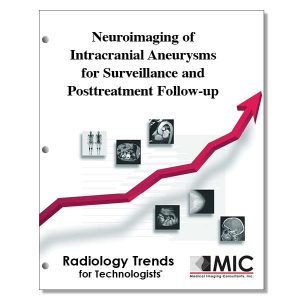

Neuroimaging of Intracranial Aneurysms for Surveillance and Posttreatment Follow-up
With endovascular treatment of ruptured and unruptured intracranial aneurysms becoming the favored technique, this course reviews modern imaging in the diagnosis, surveillance, treatment and outcomes of these patients.
Course ID: Q00703 Category: Radiology Trends for Technologists Modalities: CT, MRI, Vascular Interventional2.75 |
Satisfaction Guarantee |
$29.00
- Targeted CE
- Outline
- Objectives
Targeted CE per ARRT’s Discipline, Category, and Subcategory classification:
Computed Tomography: 2.75
Procedures: 2.75
Head, Spine, and Musculoskeletal: 2.75
Magnetic Resonance Imaging: 2.75
Procedures: 2.75
Neurological: 2.75
Registered Radiologist Assistant: 2.75
Procedures: 2.75
Neurological, Vascular, and Lymphatic Sections: 2.75
Vascular-Interventional Radiography: 2.75
Procedures: 2.75
Vascular Diagnostic Procedures: 2.75
Outline
- Introduction
- Evolving Trend toward Endovascular Treatment
- Imaging Techniques for Aneurysm Evaluation
- Noninvasive Neuroimaging: Noncontrast CT and MRI
- Noninvasive Neurovascular Imaging: CT Angiography and MR Angiography
- Three-Dimensional Time-of-Flight MRA
- Contrast-Enhanced Time-Resolved MRA
- MR Vessel Wall Imaging
- Digital Subtraction Angiography
- IA Characterization and Reporting
- Contemporary Treatment Modalities
- Clip Ligation
- Endovascular Coiling and Adjunct Techniques
- Flow Diversion
- Intravascular Flow Disruption
- Follow-Up Strategies for Untreated and Treated IAs
- Unexpected Findings at Postprocedural Follow-Up Imaging
- Device Migration or Dislodgement
- Thromboembolic Events
- Side Branch or Perforator Infarction
- Aneurysm or Vessel Rupture
- Delayed Intraparenchymal Hemorrhage
- Iatrogenic Cerebrovascular Injuries
- Unexpected Findings at Mid- to Long-Term Follow-Up Imaging
- Recurrent or Residual Aneurysm Filling
- In-Stent Stenosis
- Conclusion
Objectives
Upon completion of this course, students will:
- describe the reported incidence of intracranial aneurysms (lAs)
- list the first and second most common incidental findings on brain MR images
- describe the vessel from which lAs most commonly arise
- describe the percentage of spontaneous subarachnoid hemorrhage cases caused by lA rupture
- list the factors that affect the rupture risk of lAs
- describe the 5-year lA rupture risk based on patient age
- describe patients who have the highest risk of rehemorrhage within the first 24-48 hours
- identify the initial diagnostic study of choice for identifying subarachnoid hemorrhage (SAH)
- describe the accuracy of noncontrast CT in detecting acute SAH within the first 6 hours
- identify the diagnostic study that is recommended in cases of high suspicion for SAH following negative noncontrast CT
- list the MRI sequences with increased sensitivity for subarachnoid blood in the acute to subacute settings
- describe the detection rate of CT angiography based on lA size
- list the factors that limit detection of lAs at CT angiography
- identify the preferred imaging modality for lA screening in asymptomatic patients
- describe the MRA sensitivity for detecting lAs larger than 3 mm
- list factors that can limit the efficiency of MRA for lA detection
- identify the imaging modality used as a problem solver in clinically challenging cases
- identify the imaging modality used for diagnosis of both unruptured and ruptured lAs
- describe the incidence of permanent neurologic complications in DSA cases
- identify the imaging modality that is used to identify lA features important for determining treatment strategy
- identify the treatment that can mitigate stroke risk in the setting of intra-aneurysmal thrombus or calcification
- list the lA characteristics for which clip ligation is the preferred treatment
- list the benefits of clip ligation
- describe the most common lA treatment modality
- list the benefits of coil embolization
- describe the year the first flow diverter was approved by the U.S. Food and Drug Administration
- describe aneurysm occlusions rates 5 years after flow diversion
- describe the timepoint when retreatment should be considered after flow diversion
- describe the year the first intrasaccular flow disruptor was approved by the U.S. Food and Drug Administration
- list the reasons why 3D TOF MRA is a preferred modality for aneurysm surveillance imaging
- describe the lA recurrence rate following microsurgical clipping with complete occlusion
- describe the lA recurrence rate following endovascular coiling therapy
- identify the imaging modality that should be used for follow-up imaging to avoid metallic implant artifact
- describe the percentage of cases that experience coil migration
- list the imaging modalities used to identify coil loop herniation or displacement
- Compare the rates of technical failures between flow diverters and self-expanding stents
- describe the most common complication arising from neuroendovascular procedures
- list the factors that affect the risk of thromboembolism following treatment
- describe the prevalence of symptomatic thromboembolism during interventional coiling and flow diversion
- list the factors that affect the likelihood of side branch perforator thrombosis following flow diverter placement
- describe a devastating complication of clipping, coiling, and flow disruption device deployment
- describe a rare complication of flow diversion treatment
- list interventional devices that are sources of hydrophilic polymer coating
